Covering the Naked Man
Okayama, Japan -- One of the great things about being posted in a new country is that you get to discover its traditions. And sometimes what seems normal to the locals can seem, well, a bit peculiar to outsiders. I suppose Japan’s Naked Man Festival falls into just such a category.
I’ve heard about this festival ever since I arrived in the Tokyo bureau as chief photographer last September. The idea of the Hadaka Matsuri (Naked Man) is simple -- men first purify themselves by standing under ice-cold fountains at the Saidaiji Temple in Okayama in the west of the country, and then gather together in a type of courtyard to compete with one another to catch one of a handful of batons thrown by priests from above.
The batons are supposed to bring you good fortune, so the men try their best to catch one of them. With some 10,000 participants and only a few batons, there is major pushing and shoving involved. In the past, people have been trampled to death. They basically fight tooth and nail for a bit of luck.
 (AFP / Behrouz Mehri)
(AFP / Behrouz Mehri)For a photographer, it promised to be a great assignment, with fantastic visuals, so I was looking forward to attending the ceremony, though I have to say that it seemed a bit weird to me. “Shall we go naked as well?” I asked my colleagues in jest.
Turns out that the name of the festival is a bit misleading. The men who attend aren’t totally naked. They wear a loincloth, the same type worn by sumo wrestlers. To give you a sense of just how serious the pushing and shoving and the fighting can get -- ahead of the ritual, each man writes down his blood type on a piece of paper that he then sticks inside the loincloth, to help first responders in case he gets seriously hurt.
I love the temples in Japan. To me, they really capture the spirit of the country and of the Japanese character. You walk in and it’s very peaceful and very calm. But you feel that there is a hidden energy there, ready to burst to the surface when the time is right. I think it’s part of the culture here. In martial arts, you’re also supposed to be very calm, so your enemy will see you very relaxed. But when you fight, you fight. Very well.
When I got there, I really got a sense of just how deeply this festival is woven into the local fabric. It’s billed as a religious festival, but from what I could see, most people weren’t doing it for religious reasons, but for traditional reasons. It’s just something that they grew up with.
In fact, ahead of the main ceremony, you had a ceremony for young boys. The scale is smaller, but it’s basically the same thing. They gather into a circle and the priest goes up a ladder and throws them the small sticks. And then the boys start fighting for them. The monks watch over them carefully, but when they start fighting, the boys really fight.
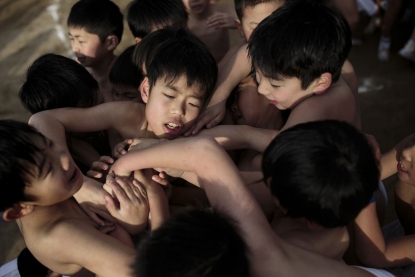 (AFP / Behrouz Mehri)
(AFP / Behrouz Mehri)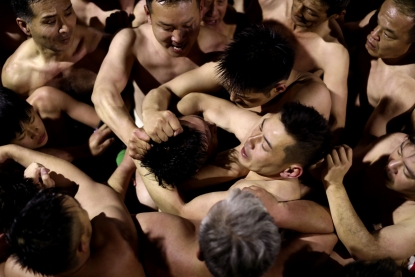 (AFP / Behrouz Mehri)
(AFP / Behrouz Mehri)
I saw people from all walks of life there. There was one group, who was preparing to go to the temple. We got to talking and one guy was into classic cars. He wore Western clothes -- jeans etc -- and he had a huge custom motorcycle that he just built for himself. He basically assembled it himself. He was not religious at all. He and the others do it to have fun, for the challenge and basically, because it was something that you did around there. It was tradition.
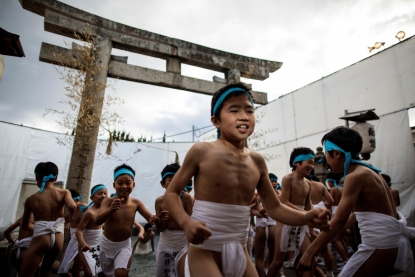 (AFP / Behrouz Mehri)
(AFP / Behrouz Mehri)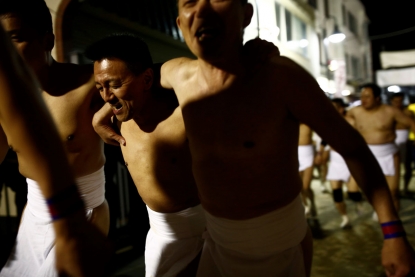 (AFP / Behrouz Mehri)
(AFP / Behrouz Mehri)
The temple itself was very beautiful. Old wooden buildings, great architecture with nice Japanese gardens. I always love being in historic sites. I close my eyes and imagine myself in a different period of time. It’s like a time machine for me.
The whole area around the temple had a festive feel to it. The streets were full of “naked” men in groups, shouting the word “vashoy,” like a battle cry before heading out into the battlefield (the word doesn’t mean anything, it’s just something that they chant)..
Police were standing on both sides of the street leading to the temple, securing the way for the throngs of “naked” men and keeping the hoards of tourists who come to watch it every year, snapping away with their professional cameras, at bay. A group of “naked” foreigners from different countries were also participating in the ceremony, with the same spirit as their Japanese brethren.
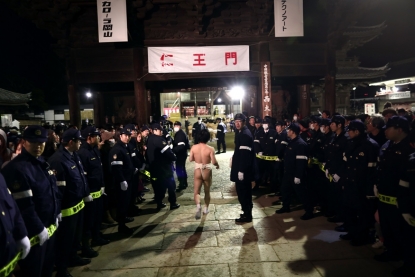 (AFP / Behrouz Mehri)
(AFP / Behrouz Mehri)Technically, it was a bit difficult for me. It’s always hard to find good angles and to prepare in your mind for how you will shoot something when you’re covering it for the first time. You can do research, etc, but nothing beats actually participating in it insofar as preparation goes.
It turned out to be a bit challenging from a logistical point of view. The best spot to shoot the baton ceremony is from the top -- that’s how you get the pictures of the writhing mass of humanity fighting each other for the sacred batons. But the positions on top were only allocated to local Japanese media, so we didn’t have access. The only way to get there was to buy a ticket and be in that top spot ahead of the start of the ceremony (tourists aren’t allowed there when the batons are thrown). So that’s what I ended up doing. I still had some nice shots, though of course I would have preferred to be there when the actual batons were thrown. Then again, if I was just at that spot, I wouldn’t have had the nice variety of shots of the worshippers.
 (AFP / Behrouz Mehri)
(AFP / Behrouz Mehri)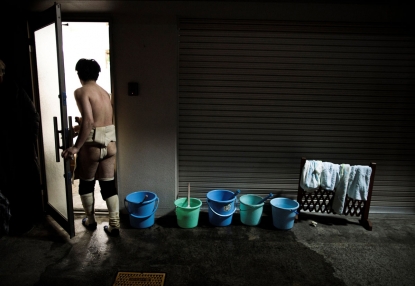 (AFP / Behrouz Mehri)
(AFP / Behrouz Mehri)
The image that will stay with me from the festival is of steam rising as thousand of groaning men, faces contorted in pain thrust their arms upward. Those who manage to catch the batons face the wrath of those around them, who try to rip them out of their hands. They have to fight tooth and nail to keep the goods and the juju that the sticks are said to bestow. One participant that we talked to afterward said he was lucky to escape -- when the baton dropped near him, he managed to quickly slip it into his loincloth and to force his way out of the mob.
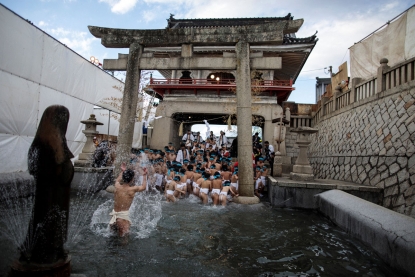 (AFP / Behrouz Mehri)
(AFP / Behrouz Mehri)When I looked at my pictures afterward, the ones with the boys and the ones with the men, it occurred to me that when people participate in their traditions, they don’t ask themselves why. They do it because it’s just part of their culture, it’s something that they’ve done since a young age.
To an outsider like me, it may seem odd that a group of nearly naked men would first bathe in freezing water and then risk serious injury to catch a baton that will supposedly bring you luck. But to the people doing it, it’s not like that at all. They have been doing it, and having fun doing it with with their friends and classmates, since they were young. It’s just part of the fabric of their culture.
This blog was written with Yana Dlugy in Paris.
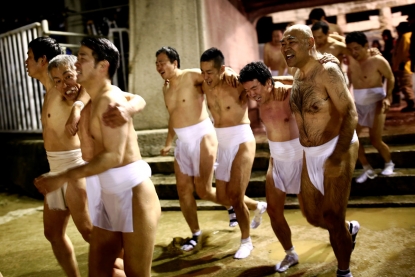 (AFP / Behrouz Mehri)
(AFP / Behrouz Mehri)


